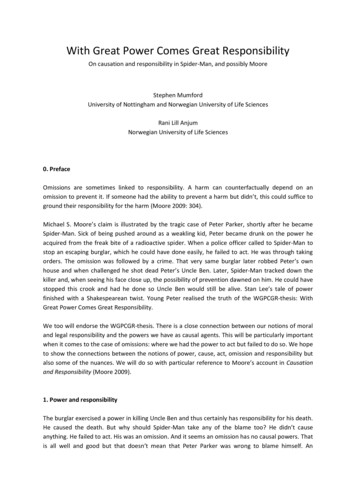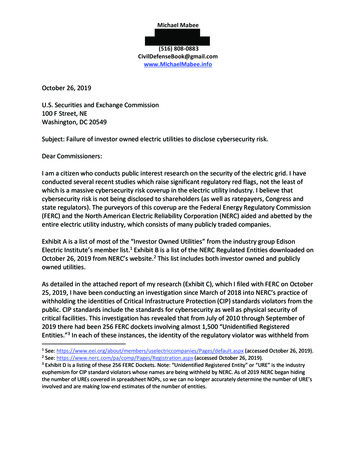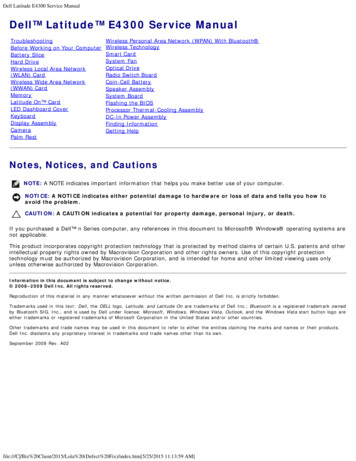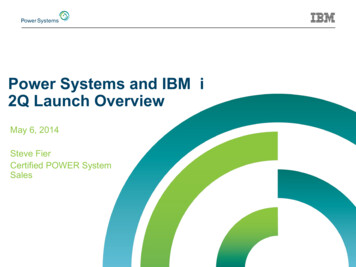
Transcription
With Great Power Comes Great ResponsibilityOn causation and responsibility in Spider-Man, and possibly MooreStephen MumfordUniversity of Nottingham and Norwegian University of Life SciencesRani Lill AnjumNorwegian University of Life Sciences0. PrefaceOmissions are sometimes linked to responsibility. A harm can counterfactually depend on anomission to prevent it. If someone had the ability to prevent a harm but didn’t, this could suffice toground their responsibility for the harm (Moore 2009: 304).Michael S. Moore’s claim is illustrated by the tragic case of Peter Parker, shortly after he becameSpider-Man. Sick of being pushed around as a weakling kid, Peter became drunk on the power heacquired from the freak bite of a radioactive spider. When a police officer called to Spider-Man tostop an escaping burglar, which he could have done easily, he failed to act. He was through takingorders. The omission was followed by a crime. That very same burglar later robbed Peter’s ownhouse and when challenged he shot dead Peter’s Uncle Ben. Later, Spider-Man tracked down thekiller and, when seeing his face close up, the possibility of prevention dawned on him. He could havestopped this crook and had he done so Uncle Ben would still be alive. Stan Lee’s tale of powerfinished with a Shakespearean twist. Young Peter realised the truth of the WGPCGR-thesis: WithGreat Power Comes Great Responsibility.We too will endorse the WGPCGR-thesis. There is a close connection between our notions of moraland legal responsibility and the powers we have as causal agents. This will be particularly importantwhen it comes to the case of omissions: where we had the power to act but failed to do so. We hopeto show the connections between the notions of power, cause, act, omission and responsibility butalso some of the nuances. We will do so with particular reference to Moore’s account in Causationand Responsibility (Moore 2009).1. Power and responsibilityThe burglar exercised a power in killing Uncle Ben and thus certainly has responsibility for his death.He caused the death. But why should Spider-Man take any of the blame too? He didn’t causeanything. He failed to act. His was an omission. And it seems an omission has no causal powers. Thatis all well and good but that doesn’t mean that Peter Parker was wrong to blame himself. An
GREAT POWER GREAT RESPONSIBILITY2omission can sometimes have just as much moral significance as an act as Moore says and we willback that claim in this paper.The WGPCGR-thesis has an intuitive attraction through its connection of the notions of power andresponsibility. In the first place, one can only be held responsible for something not happening if onehad the power to bring it about. No human can have a responsibility to jump to the moon or breathe(unaided) underwater. Without the power, the responsibility makes no sense. In the second place,the WGPCGR-thesis also draws a connection between degree of power and degree of responsibility.When a man is drowning in a lake, the stronger swimmer in attendance has more responsibility tojump in and save him than does a weaker swimmer. If a woman is knocked down by a car, a trainedmedical doctor who is present has more responsibility to assess and care for her than does anonlooker with mere first aid training or no training at all.Blame can then attach to persons who fail to act when they have the power and responsibility to doso. No one was to blame for the earthquake off the coast of Japan in 2011 because no one had thepower to stop it. But someone could be to blame for an assault or a theft or even an accident ifnegligence played a role. Blame comes from neglect of responsibilities. It doesn’t always come fromthe failure to exercise a power, however, because some of them we have no responsibility toexercise. Responsibility is a normative matter whereas power need not be. We have the power totalk all day non-stop but we have no responsibility to do so. We also have the power to strangle apasser-by. We have no responsibility to do so and indeed in almost all conceivable cases have aresponsibility not to do so. It is up to moral and legal theory to tell us which of our powers we have aresponsibility to exercise and on what occasions. What it cannot fairly tell us, however, is that wehave a responsibility to do something that we simply cannot.An apparent exception is not really one. You may not know first aid and thus have no power to savea collapsed man. But perhaps you had a moral responsibility to have learnt first-aid in the first place,just in case of needing it. Hence, it might be argued, you have a responsibility to save the man eventhough you don’t have the power to do so because, for instance, you don’t know the recoveryposition. But this apparent responsibility without power arises only by conflating first and secondorder powers. If you don’t have the power to administer first aid you have no responsibility to do soas you could do harm if you make a clumsy attempt (you may nevertheless have a responsibility tooffer general assistance and reassurance). But you had the power to learn first aid and it isconceivable that you could have had a responsibility to do so. You might then be blamed if youdon’t. One may, therefore, have a second-order responsibility to do something (to acquire a powerto act) while at the same time lacking the corresponding first-order responsibility (to exercise theacquired act). This is no real exception to the WGPCGR-thesis then.2. Powers and causal dispositionalismWe aim to explore further the connections between causation and responsibility and we do so usingthe framework of causal dispositionalism, a theory of the metaphysics of causation developed in
GREAT POWER GREAT RESPONSIBILITY3Mumford and Anjum 2011. We will explain the basics of the theory in order to show its applicationto the issue of responsibility.Causal dispositionalism is a theory of causation based on a metaphysics of real causal powers ordispositions. Such a philosophy of nature is associated with Aristotle and Aquinas and is nonHumean. It is not a reductive analysis as the notions of cause and power are too closely connected. Itaccounts for causes in terms of the exercise of powers, where effects are typically produced by manypowers acting together. When we have multiple powers producing an effect it is called polygeny.We model polygenic powers acting together using vector diagrams (whereas the conventions ofstandard neuron diagrams – the other main way of representing causal situations – allow only oneimmediately prior cause for each effect). Moore also allows that many factors can work together toproduce an effect. He calls them concurrent causes (Moore 2009: 486). Figure 1 shows us anexample of multiple concurrent powers at work.We model powers as vectors because powers have a direction: there is something towards whichthey dispose. Vectors also have a direction, which we show in the figure by plotting them on aquality space that ranges from the property F to the property G. These could indicate the propertiesof being hot and being cold, for instance, and the powers that emanate from a central vertical line –the current temperature – indicate powers towards raising the temperature, F, or lowering thetemperature, G. Powers can also have a magnitude or intensity, which the vector indicates by itslength (the longer, the stronger). Again this is important but frequently overlooked. We should allowthat causation is scalar (Moore 2009: 105). Both causes and effects can occur to some degree. Whatproduces an effect is all the concurrent powers working together. They compose, indicated byresultant vector R, into one big power: how the overall situation disposes. Powers thus become thetruthmakers of all the causal truths. All effects are produced by powers exercising themselves invarious combinations.adbFecGfRFigure 1: Multiple powers at workAn upshot of causal dispositionalism is that we should separate the notion of causal production fromthat of causal necessitation. Powers produce their effects without guaranteeing them. Instead wehave tendencies towards certain outcomes. A cause is thus something that tends or disposestowards its effect. This is something more in the world than Humean regularity: we have real powersthat bring with them a genuine modal connection between causes and effects. But the modalconnection is one of tendency, short of fully-blown necessity, as Aquinas saw (see Geach 1961: 102).The polygeny depicted in figure 1 shows us that if there had been a further power, h, disposingtowards G, powers a-f might not have brought about a movement towards F. We call this additive
GREAT POWER GREAT RESPONSIBILITY4interference, which shows that causes do not necessitate their effects, even on the occasions theysucceed in producing them.3. Causation and responsibilityThe law often seeks to apportion blame or responsibility according to the degree of a cause. Thisseems to be one area in which the metaphysics of causation has much to learn from the philosophyof law. The importance of the scalarity in causation is often neglected or indeed ignored completely.Lewis’s influential counterfactual dependence account (Lewis 1973), for example, suggests anaccount in which causes and effects are all or nothing. The accompanying neuron diagrams are ableto show only that a cause or effect happened or it did not: not that they might happen to somedegree.Degrees of cause and responsibility are important matters in law. Because of the polygenic aspect ofcausation, in which an effect is typically produced by many causes working together, one might needto single out what was the main cause of the harm before judging responsibility. The main cause isthe biggest contributor for the harm: what in figure 2 would be represented as the longest vector. Inapportioning legal or moral responsibility, therefore, we might judge whether a particular factor wasonly a small part of the total cause, or instead the main contributor.But in judging responsibility, there are further factors to be considered. A small factor cannevertheless by highly significant. Someone who has developed lung emphysema might, forinstance, blame the factory that they worked in for over 30 years, exposing the employees fordamaging dust particles. But if in court it emerges that the worker was also a heavy smoker andgenetically pre-disposed for the disease, the defence could argue that the smoking was the maincause and not the dust particles from the factory. Does this mean that the factory owner is withoutresponsibility? No. It might still be that the exposure to the dust particles from the factory was whattipped the situation over the threshold of the lung emphysema. This might have been just a smallcontributor, but one that made the outcome radically different (represented by power f in figure 2).The factory owner could then be responsible and held liable for partial damages.TfFGRFigure 2: A cause, f, that is not the main causeA tiny contributor can thus make a large difference for the outcome if we have a so-called tippingcase (figure 3). Where we have a tipping case situation the operating powers are very close to athreshold at which something happens: they are all lined up and ready to go such that just a very
GREAT POWER GREAT RESPONSIBILITY5small addition would be enough to reach that threshold. Hence, a very small extra input could leadto a huge difference in outcome. If a rock is balanced on a cliff edge, for instance, just a push from apassing ant might be enough to send it hurtling down a ravine (see Moore 469).TFGRFigure 3: The set-up for a tipping caseIt is conceivable that major legal and moral responsibility could be allotted to a small causal factor ifit is indeed the one that tips a causal situation over a threshold. Instead of a rock and an ant at thecliff edge, we could easily manage a man standing there, struggling against the wind to keep hisbalance. If a bystander then comes and gives them a push – even a very slight push – they mighthave major responsibility for a subsequent death.So much for causation. But we also know that responsibility comes from omissions. How does thatwork? In the next section, we argue that an omission is an occasion for an effect, not its cause.4. Omissions: responsibility without causationOmissions prima facie create a problem for causal dispositionalism. It looks like they produceoutcomes and yet they are not actions: they are lacks of action, where a lack of something is nothingat all. We take it that agency involves people causing effects through exercise of their powers. If thatis anywhere near right, then omissions are thus the agency version of causation by absence. Somephilosophers accept that absences can be causes (Shaffer 2004), citing commonplace examples suchas lack of water killing a plant, a horse shoe falling off for want of a nail and the guillotine causingsomeone to die through lack of a head. Causal dispositionalism, however, tells us that effects areproduced by powers exercising themselves. Absences, lacks and omissions are not real things in anyway, however. They are precisely something not being there. If we have nothing, therefore, wecannot have causal powers. We thus want to agree with Moore when he says that omissions cannotbe causes (Moore 2009: 54). Nothing comes from nothing: we reject causation ex nihilo. But then weowe a metaphysical account of how causation by absence appears to happen. What is really goingon in such cases?Fortunately, the vector model allows us to explain causation by absence entirely in terms of whatthere is: the powers of things that really are, rather than any alleged powers of nothingnesses. Theaccount will also show why we can attribute responsibility without causation, in the cases ofomissions.
GREAT POWER GREAT RESPONSIBILITY6In abstract terms, what is suggested is that in cases of putative causation by absence removal of apower is the occasion on which powers disposing in the opposite direction win out. In figure 4, wehave two powers disposing towards F and two towards G. If they are jointly of equal strength, wewill have an equilibrium situation in which nothing happens. But if we now remove one of thepowers disposing towards F (represented by vector a), then the powers disposition towards G will bethe stronger. Overall, the situation will then dispose clearly towards G (indicated by the brokenresultant vector R). The crucial insight, from a metaphysical point of view, is that it is the remainingpowers towards G that do the causal work of producing G. The absent power a is no longer thereand does nothing. We try to indicate this by saying that the removal of a was the occasion for thecausing of G without being one of the causes of G. When a was removed, the remaining powerstowards G were able to do their work: but it was the remaining powers towards G that did all thecausing, not the absent a.FGaRFigure 4: ‘Causation by absence’A concrete example will illustrate the abstract account. Consider a game of tug of war betweenphilosophers and theologians. The sides are equally matched and the rope goes nowhere. One weakwilled philosopher gives up and leaves the contest, whereupon the theologians achieve a quickvictory. Did the absent philosopher cause the theologians’ win when he left the contest? No. All thecausing of that result was due to the forces exerted on the rope by the theologians pulling. But thephilosopher giving up was the occasion for their victory insofar as he had previously been holdingthem back. The philosopher’s teammates may well apportion responsibility to their weak-willedcolleague. Would they have avoided defeat had they remained at full strength? If so, they would beright to think of their team-mate giving up as the occasion for the theologians win, even if the givingup was not the cause.Peter Parker was obviously mindful of all this. He didn’t cause his Uncle’s death, even though he hasmistakenly thought so since. The burglar’s bullet did the causing. But he rightly has understood thathis omission occasioned the killing to the extent that it would probably not have happened if he hadacted. What he had in mind was thus a sine qua non rather than a real cause: a distinction we willexamine further.5. Overdetermination and prevention: responsibility without counterfactual dependence
GREAT POWER GREAT RESPONSIBILITY7An attractive explanation of this would be in terms of counterfactuals. Had the philosopherremained, the theologians would not have won. In that case, blame is apportioned. This story, whichMoore (2009: 304) endorses, is basically right (see also Dowe 2001). But it needs to be nuanced invarious ways because the connection between causes, omissions and counterfactual dependences isnot a simple matter, certainly if one accepts the insights of causal dispositionalism.The counterfactual truths, such as they are, can indeed be made true by the worldly powers ratherthan, for instance, the plurality of worlds (Lewis, 1986). The counterfactual situation really iscontrary-to-fact, though: contrary to all facts. There are no facts – not even in other worlds – thatthey are about. Mere possibilities are fictions and their ontological status is thus akin to truth infiction. But a power gives us more than a mere possibility of its manifestation. As stated above, thereis a more than Humean modal connection involved in causation, according to causal dispositionlism,such that if a cause occurs, its effect will also tend to occur. As we stated, however, this is not amatter of necessitation of the effect.The dispositionalist view thus has implications for how we understand any associatedcounterfactuals. Two counterfactuals interest us when it comes to causation:i. C and E occur and C caused E. C had the power whose manifestation was E, such that had there notbeen C, there would not have been E.ii. Neither C nor E occur. But had there been C, there would also have been E, because C was thepower whose manifestation was E.According to causal dispositionalism, however, we have reasons to accept neither i nor ii. In the caseof ii, a thoroughly dispositionalist account cannot say that if C occurs, E will occur: only that it will bedisposed to occur. In the case of additive interference, something is added that can prevent E eventhough C. Hence, even if Spider-Man had exercised his powers and tried to stop the Burglar, hecannot know for sure that he would have succeeded. Causal prediction is fallible and for a goodreason. Even Spider-Man’s action could have been prevented, for instance if the incredible Hulk hadrestrained him.We reject i because of the possibility of overdetermination. Many causes do make a difference tothe world. Had they not occurred, something else might not have occurred. But not all causes makea difference. Some effects are overdetermined (Moore 2009: 411-25). They have more than onecause or set of causes each of which alone could have produced the effect. Two assassins, forinstance, working independently each put a deadly dose of poison in their victim’s drink. The victimconsumes it and dies. If we thought of causation and responsibility in terms of counterfactualdependence, each assassin could claim innocence. Their poison made no difference given that theother dose was lethal. Neither assassin’s action was a sine qua non for the victim’s death. There is noshortage of other examples. For example, two brain neurons N1 and N2 fire simultaneously and eachwould alone have been enough for the passing of the threshold for N3 to then fire (Moore 2009: 416,example from Lewis). The firing of N3 is overdetermined.
GREAT POWER GREAT RESPONSIBILITY8Defenders of the counterfactual dependence theory of causation have gone to great lengths toexplain away the possibility of overdetermination. It threatens the core difference-making intuitionof the theory. And yet there seems nothing unintuitive about overdetermination itself. In that case,it looks as though the amendments to the theory that have been designed to avoid the problem aread hoc with no greater motivation than to salvage the theory. In contrast, the causal dispositionalisttheory can accept the intuitive possibility of overdetermination without any further amendment orcost to the theory. We simply accept that two powers a and b, or sets of powers, each could get thesituation over a particular threshold for an effect to occur (figure 5).TaFbGFigure 5: Causal OverdeterminationWhat we need to do, therefore, is recast both our counterfactuals in dispositional terms, which wecan do:i*. C and E occur and C caused E. C had the power whose manifestation was E such that had therenot been C, it would not have disposed towards E (though something else might have).ii*. Neither C nor E occurs. But had there been C, it would have disposed towards E, because C wasthe power whose manifestation was E.Despite these amendments, i* and ii* can still serve as a basis for responsibility. An agent’s actionsdo not necessitate an outcome and nor can we be sure that their action made a difference, if theeffect was overdetermined. But we can still hold people responsible for actions that dispose towardsan outcome. Someone who sells a dangerous drug, for instance, can still be responsible for a death itsubsequently produces even if it did not guarantee the death. Producing it is enough. Similarly, ifwould be a weak defence to argue that only half of those who took the drug died and death was nottherefore within the control of the drug seller. Had Spider-Man tackled the burglar, it would havedisposed strongly towards them being apprehended and committing no murder that evening. Thefact that the Hulk had the power to restrain Spider-Man does not affect his responsibility throughomission. And it would further be a bad defence that one’s own poison made no difference to thevictim because they were ingesting the other assassin’s lethal dose. More to the point is that thefirst assassin’s dose was lethal: it had the power to kill the victim whether or not anyone else hadalso introduced a lethal dose.6. Transitivity and responsibility
GREAT POWER GREAT RESPONSIBILITY9Despite what we take to be the inadequacies of a counterfactual dependence theory of causation,the counterfactual or difference making notion of cause still holds some power (Moore 2009: 371).But we will argue that this sine qua non notion is clearly distinguishable from genuine causation. If itreally were causation, there would simply be too many causes: Many things will be a sine qua nonfor an effect without being a cause of it. In this and the next section we will try to resolve the issuesof causal chains, transitivity and necessary conditions and it should then be clear how a cause differsfrom a sine qua non.Causal responsibility often works via intermediaries. This can result in causal responsibility thatstretches back many years. One may be responsible for someone’s death even if one caused it via aseries of intermediate steps. Perhaps one ‘only’ pushes a rock, but if the rock is on the edge of a cliffunder which one’s enemy is stood then one may be guilty of murder, depending on thecircumstances. And if that works with just one intermediate cause, there seems no reason why onecouldn’t murder someone via many steps, as with a Heath Robinson or Rube Goldberg machine forinstance (an elaborate mechanical contraption with many operating stages).As soon as we allow causation to transfer through intermediate causes we get into the issue of thetransitivity of causation. A common metaphor that is used is the causal chain, which conveys theidea that causation consists in a sequence of events or links with strong connections between eachof those links. A causal dispositionalist has reasons to be suspicious of that metaphor, however. Inthe first place, the idea of links in the chain suggests something strong and unbreakable but we havealready said that causes do not necessitate their effects but tend towards them only. The links of thechain are far from unbreakable. But the metaphor also ignores what we take to be an essentialfeature of causation, namely its polygeny. Neuron diagrams, it will be recalled, show us only onecause for every effect. Lewisians do not think that this is the case for causation generally: they allowthat causes can be complex. But their project is to explain what it is to be a cause of an event(among others) and there cannot be more than one, in the circumstances, that was sufficient for theeffect; that is, upon which the effect counterfactually depends. As we saw above, a counterfactualdependence theory cannot allow effects to be overdetermined. The image of a chain is thusparticularly suited to the conventions of neuron diagrams, which in turn is particularly suited to thetwo-event-plus-relation model of Humean and Lewisian theories of causation (see Martin 2008: 46and Mumford and Anjum 2011: ch. 2).Moore offers us a better metaphor: one that shows the polygeny of effects. We should think insteadof a backwards causal cone (Moore 2009: 276). A particular effect has three causes, say, but theneach of those three causes has three causes, and so on. We can see that the further back in time onegoes, the more causal ancestors an effect will have. We endorse the idea of the causal conemetaphor instead of the causal chain. What bearing does this have on responsibility?Moore allows that:
GREAT POWER GREAT RESPONSIBILITY10Causation is then pictured as an inverted cone. The further up the cone from e is some c, theless causal contribution it makes to e (because it is joined by so many other causes). Thuslater is usually greater, when it comes to degrees of causation. (Moore 2009: 72)This gives Moore, he thinks, a reason to put limitations on transitivity of causation. If c1 cause c2, andc2 causes c3, and so on to cn, we cannot always say that c1 caused cn. The reason is that causationweakens and then peters out through time (Moore 2009: 121-3, 224 and 397-9) and thus need notalways transfer from an earlier causal transaction to a later one in the same causal cone. An earliercause will be one among more than a later cause so it has less of a responsibility for the final effect.And we can go so far back in the causal history that we reach de minimis causes, which are among somany that they should not properly be thought of as causes at all. Causation and thus responsibilityare not always transitive, therefore. Some causes will have petered out with respect to some latereffect. We can think of causes as petering out over time insofar as time is a good indicator or proxyfor how many causal transactions have occurred (Moore 2009: 122).We accept that transitivity can fail but not for the reasons Moore gives. He is right that we do notgenerally consider, for instance, a distant event such as the Big Bang to have been the cause ofsomeone speeding or being involved in a car accident even if we accept that it is part of itsbackwards causal cone (arguably a part of everything’s backwards causal cone). But there are twoproblems with Moore’s account. First, the limit at which a cause moves from just being one smallcause among many others to not being a cause at all – one that has petered out – would seem to bearbitrary. It would not be something dictated by nature but only by our decisions. Do we say c can bea cause of e if it is one among a thousand causes of e but not if it is one among a thousand-and-onecauses (or ‘no-longer causes’) of e? Do we say that the causes of e must have occurred within itsprevious ten years but no longer? The world and its causal cones seem to involve a smoothcontinuity of degrees of influence rather than any sharp and obvious cut off between being a causeand not being a cause. Second, Moore’s diagnosis would seem to imply that factors in e’s backwardscausal cone of equal temporal distance from e are either both causes of e or both not causes of e.But it seems a possibility that we think of one thing ca as a cause of e even though cb, which occurredat the same time as ca and is also in e‘s causal cone, is not a cause of e. A cause of a bridge collapsingmight be the use of a batch of weak rivets 50 years previously. At the same time and elsewhere onthe bridge some adequate and strong rivets could have been used. The latter seems to be within thecausal cone of the bridge’s collapse but would not be thought of as one of its causes.This last example gives a clue as to what we think the right answer is for why transitivity can fail andthe answer is within the spirit of dispositionalism. Clearly, some factors in the causal history of anevent dispose towards the effect in question and others don’t, even though they are indeed parts ofits causal cone. Weak rivets dispose towards the bridge’s collapse (even if it takes them 50 years tomanifest their disposition) while strong rivets don’t. And the Big Bang, while it is a part ofeverybody’s backwards causal cone, does not dispose towards anybody speeding (or slowing down).It is not merely that the causal effects of the Big Bang have faded away over time (Moore 2009: 121uses the metaphor of emanating ripples in a lake caused by the dropping of a stone and fading awayto nothingness over the lake’s surface). Indeed, there are still things happening now for which theBig Bang can be identified as the major cause: the ongoing expansion of the universe, for instance.
GREAT POWER GREAT RESPONSIBILITY11Geological causes can also stretch over a lot of time. Temporal distance does not automaticallyexclude causation, therefore. Rather, causes are selective about what it is, at a certain distance, theycause and what they don’t. Dispositionalism can explain the difference. Causes dispose towardssome manifestations rather than others, even if it takes them a long time to manifest thosedispositions.We have an alternative to Moore’s account o
With Great Power Comes Great Responsibility On causation and responsibility in Spider-Man










